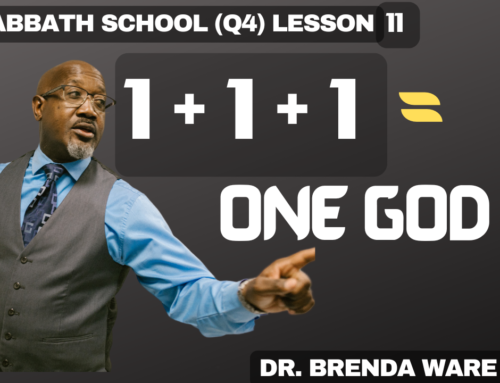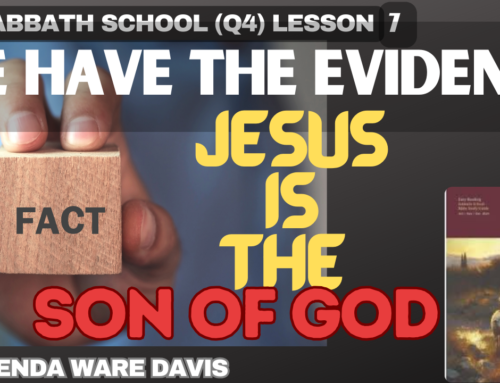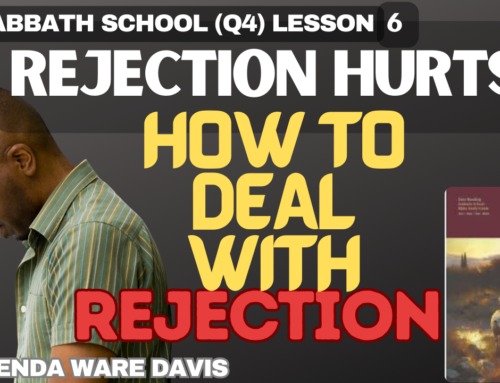KEEPING THE KNOT TIED AFTER THE WEDDING
Weddings are special. They mark a new chapter in a couple’s life. They represent the commitment, love, and care they have for each other as they come together to build a life together. Weddings are beautiful. But you have not seen one so special as the one described here. It will be a sight to behold.
We are continuing our study of the Book of Ephesians. This week we are looking at Ephesians 5:21-33. Still focusing on the theme of unity, Paul moves toward the relationship between husband and wife, offering counseling on marriage and using the image of the relationship between husband and wife to our relationship to God, Christ, salvation, creation, and the church.
You may view our past and present videos at SabbathSchoolDaily.com.
You may obtain the study guide for this series at Sabbath.School or ssnet.org, all of which are at no cost to you.
Let Us Inviting God’s Presence:
Holy Father, thank you for loving us so much that you, through Christ, are willing to enter an intimate relationship with us. Give us hearts and minds to accept your proposal. In Jesus’ Name, Amen.
It is a comforting thought to know just how much Jesus loves us. The relationship Jesus has for us helps us understand how we should treat each other in a marital relationship, friendship, or even others.
In the previous video, we found out what Jesus, as the bridegroom, does to prepare his bride, the church, for their grand wedding.
Just as a husband is to love his wife, Jesus loves the church. As husbands in ancient wedding ceremonies gave a bride price, Jesus gave the ultimate bride price; he gave his life.
In contrast to the bridesmaids and her family preparing the bride for the bridegroom, Jesus, the bridegroom, bathes, that is, cleanses, and prepares the bride, his church, for the grandest wedding.
We discovered that this cleansing is performed with words, pointing to the promises that God, the divine Bridegroom, makes to his bride. (Split)
Finally, the Bride is prepared to be presented to her Groom. She is now most beautiful, appearing in her purity and majesty.
Now that she is ready to be present to the Groom, who presents her?
Who gives her to the groom?
Paul in 2 Corinthians 11:1-4 uses ancient wedding traditions to show the believers in Corinth the similarity between those who take care of the bride and Christ, who takes care of the church. He says: (Split)
1 Oh, that you would bear with me in a little folly—and indeed you do bear with me.
2 For I am jealous for you with godly jealousy. For I have betrothed you to one husband, that I may present you as a chaste virgin to Christ.
3 But I fear, lest somehow, as the serpent deceived Eve by his craftiness, so your minds may be corrupted from the simplicity that is in Christ.
4 For if he who comes preaches another Jesus whom we have not preached, or if you receive a different spirit which you have not received, or a different gospel which you have not accepted—you may well put up with it! (2 Corinthians 11:1–4)
He also uses this same analogy in Ephesians 5:25–27,
25 Husbands, love your wives, just as Christ also loved the church and gave Himself for her,
26 that He might sanctify and cleanse her with the washing of water by the word,
27 that He might present her to Himself a glorious church, not having spot or wrinkle or any such thing, but that she should be holy and without blemish.
(Ephesians 5:25–27)
So, Paul uses a wedding, a marriage ceremony, to explain Jesus’ relationship to his church.
He said that Jesus is like the one taking care of the church, just like a groom takes care of his bride.
But what’s the connection between the bridegroom in a wedding and Jesus’ relationship with the church?
Paul explained it like this:
(1) First, it’s the betrothal. It’s like they’re getting ready to be married. Jesus did everything he could for the church, like paying a special price, a bride price, for her. (Ephesians 5:25)
(2) It’s the preparation. Then, like the bridesmaids who help the bride get ready for the groom, Jesus helps the church get ready. He cleans and sanctifies her. He makes her special. (Ephesians 5:26)
(3) It’s the wedding ceremony itself. Just like a wedding, it is finally the wedding day. Just like the bride is made to look amazing for her bridegroom. Jesus is making the church look amazing, like a bride on her big day. (Ephesians 5:27)
This last part is about when Jesus comes back. Like the groom who comes to get his bride, Jesus comes to get his bride (the church) and shows her off to everyone.
Notice what Paul says about the wedding and Jesus’ preparation of the bride in the following scriptures.
Ephesians 5:27
27 that He might present her to Himself a glorious church, not having spot or wrinkle or any such thing, but that she should be holy and without blemish. (Ephesians 5:27)
Colossians 1:21-23
21 And you, who once were alienated and enemies in your mind by wicked works, yet now He has reconciled
22 in the body of His flesh through death, to present you holy, and blameless, and above reproach in His sight—
23 if indeed you continue in the faith, grounded and steadfast, and are not moved away from the hope of the gospel which you heard, which was preached to every creature under heaven, of which I, Paul, became a minister.
28 Him we preach, warning every man and teaching every man in all wisdom, that we may present every man perfect in Christ Jesus. (Colossians 1:21-23, 28)
So, when Jesus comes back, it going to be a grand celebration.
As a matter of fact, back in the old days, ancient weddings started with a nighttime parade. Jesus paints an amazing picture of the bride preparing to meet the bridegroom. You can read it in Matthew 25:1-13.
You see, the groom and his friends, his entourage, would gather at the groom’s home, the couple’s new home. In a parade procession, with great rejoicing, they would go to the home of the father of the bride with music and lighted torches. They would either gather at the home of the father of the bride or, on the way, meet the bride in her own bridal procession. Then the parade would continue with the bride and the groom to their new home, where they would have a huge week-long celebration, ending with the wedding ceremony at which time the bride is presented to the groom.
Sounds like a grand occasion! Right? So, when Paul talks about Jesus presenting the church to himself, he’s talking about this parade and the showing off of his bride.
This portrayal helps us think about how Jesus will come back and celebrate with the church. This will be the grandest and most spectacular wedding celebration ever! It will be a sight to behold!
The point Paul is making is Jesus really cares about the church. It’s like a special bond between a husband and wife.
Look what it says in the book God’s Amazing Grace about this grand occasion:
With uplifted heads, with the bright beams of the Sun of Righteousness shining upon us, with rejoicing that our redemption draweth nigh, we go forth to meet the Bridegroom.
A little longer, and we shall see the King in His beauty. A little longer, and He will wipe all tears from our eyes. Then by innumerable voices will be sung the song, “Behold, the tabernacle of God is with men, and he shall dwell with them, and they shall be his people, and God himself shall be with them, and be their God” (Revelation 21:3).—God’s Amazing Grace, p. 358.
Paul uses a wedding to explain the deep connections we have with Jesus. Paul’s description is also a reminder of the importance of celebrating and nurturing the relationships we have in our own lives. We should spend time nurturing and cherish the time we have with each other. For in this world, we never know if it is our last.
That’s why Paul does not conclude his instruction to the Ephesians with this culmination between Jesus and his bride, the church. Because how we treat one another in this world determines if the wedding will be consummated or not.
Thus, Paul goes on to make a strong argument for how husbands should treat their wives. What point does he make? Read Ephesians 5:21 to 6:9. Then continue to part 5: Love Your Wife as You Do Yourself.
Ephesians
(Lesson 10)
Husbands and Wives: Together at the Cross
Part 5: Love Your Wife as You Do Yourself
In Ephesians 5:21–6:9, Paul offers healthy guidelines for Christian living.
For instance, in Ephesians 5:28–30, He addresses husbands who might consider following the customs of the time and fall into the pattern of hating their wives.
Therefore Paul says:
28 So husbands ought to love their own wives as their own bodies; he who loves his wife loves himself.
29 For no one ever hated his own flesh, but nourishes and cherishes it, just as the Lord does the church.
30 For we are members of His body, of His flesh, and of His bones. (Ephesians 5:28–30)
He used the rationale for husbands loving their wives to that of wives being the husband’s own flesh (bone of his bone and flesh of his flesh).
A man who hates himself might abuse and beat his wife. But who in his right mind “hates his own body.”
The thing is, in Paul’s day, in the Greco-Roman world, the father of the family had a lot of power. By law, the father of the household had the power to punish or kill his wife, children, and slaves.
Now, that’s too much power! But though they had that kind of power, it was restrained by public opinion.
Paul gives an even greater reason for husbands to love their wives in Ephesians 5:25–27. Here, Paul gives the ultimate example of what love is. Paul uses as his example Jesus’ love for the church.
25 Husbands, love your wives, just as Christ also loved the church and gave Himself for her,
26 that He might sanctify and cleanse her with the washing of water by the word,
27 that He might present her to Himself a glorious church, not having spot or wrinkle or any such thing, but that she should be holy and without blemish. (Ephesians 5:25-27)
This example gives husbands a new and drastic model to follow for how to love. Paul tells Christian husbands to love their wives in the same way that Jesus loves His bride, the church.
Jesus had so much love for his bride (the church) that he died for his church. Now, that takes some kind of love. That is ultimate love.
A husband who loves his wife, like Jesus loves the church, will love, cherish, honor, and protect his wife. For Jesus takes care of his bride’s every need.
Paul expresses that husbands professing Christ should not behave like husbands who are non-believers. They should instead seek to match the love Christ has for his church.
Therefore, Paul’s aim In Ephesians 5:28–30 is to give Christian husbands a new reason to love their wives: self-love. Paul says, “No one ever hates his own flesh” (Ephesians 5:29).
His point is that Christian husbands, or any husband for that matter, should never ever abuse or hurt their wives. They should instead “nourish and cherish” them.
So, Paul was an advocate against spousal abuse in any form, physically, mentally, or emotionally. He calls for husbands to remember that they and their wives are joined together as one.
They are one flesh or one person. So, if a husband harms his wife, he is harming himself. And most people in their right mind do not want to harm themselves.
Notice what it says in Patriarchs and Prophets:
God Himself gave Adam a companion. He provided “an help meet for him”—a helper corresponding to him—one who was fitted to be his companion, and who could be one with him in love and sympathy. Eve was created from a rib taken from the side of Adam, signifying that she was not to control him as the head, nor to be trampled under his feet as an inferior, but to stand by his side as an equal, to be loved and protected by him. A part of man, bone of his bone, and flesh of his flesh, she was his second self, showing the close union and the affectionate attachment that should exist in this relation. “For no man ever yet hated his own flesh; but nourisheth and cherisheth it.” Ephesians 5:29. . . . Patriarchs and Prophets, p. 46.
Paul uses Jesus as an example to both wives and husbands. He is saying, treat your wife the way you treat yourself, or better yet, use Jesus as your model for how you treat your wife.
This one flesh idea that Paul talks about sounds great(, but where did he get it from?
Read: Genesis 2:15–25, then proceed to Part 6: The “One Flesh” Model of Marriage (Split)
Ephesians
(Lesson 10)
Love Your Wife as You Do Yourself
Part 6: The “One Flesh” Model of Marriage
The creation story in Genesis 2:15–25 tells us that after God made the skies and the earth, He created the husband. Then, He formed the wife from his rib. He joined the wife and husband together, and in Genesis 2:24, we find that the two became one.
24 Therefore a man shall leave his father and mother and be joined to his wife, and they shall become one flesh. (Genesis 2:24)
In Paul’s marriage counsel to husbands and wives in Ephesians 5:31, he uses the quote from Genesis 2:24 to conclude his counseling on marriage.
31 “For this reason a man shall leave his father and mother and be joined to his wife, and the two shall become one flesh.” (Ephesians 5:31)
As Paul talks about the creation story, he points out the needs in Christian congregations and the need for healthy families within these congregations.
Thus, Paul believes that Genesis 2:24 is not just good for ancient Israel but also good counsel for marriages in every generation.
By creation and design, God intended marriage to be a “one flesh” relationship. The sexual relationship between a married couple is used to symbolize the way that the husband and wife are joined to become one in marriage.
It is an emotional and spiritual unity that reflects their hearts, minds, bodies, and spirits joined together as one.
Genesis 2:24 gives us a deeper understanding of the love between Christian husbands and wives.
Now, notice that Paul selected a quote about marriage from a time before the fall. This was a time when there was no sin in the world.
Unfortunately, we live in a post-Fall world that is filled with sin. In contrasting marriage before the fall and marriage after the fall, it becomes evident that the sexual relationship between a man and a woman today has been exploited.
Marriage before the Fall casts light on how deeply entrenched in our modern cultures is the idea that sexual union represents that a woman should be under the full control of a man and serve him the same as a slave. But that is not what God intended, and it is not what the Bible teaches.
Paul argues that sexual relationship, as reflected in Genesis, was intended to be about a man and a woman becoming one body, heart, and spirit in marriage. In other words, it does not symbolize or represent the dominance of the male but the union of husband and wife, such that they are “one flesh.”
It is not God’s intent that the husband controls the mind and body of the wife. God did not make the wife to be the husband’s slave.
Instead, the Bible teaches that in marriage, the husband and wife become the same as one body, one flesh.
So, for a clear understanding of how husbands and wives should behave and love each other in marriage, we look to Ephesians 5:21–33 and Genesis 2:24. These Bible verses, we can all agree, propose an opposite way of life. They are totally counter to how the world views marriage and sexuality today.
Thus, in Ephesians 5:32, Paul talks about a “profound” mystery. This mystery is the wonderful teaching of Jesus’ love for His church.
This helps us understand the Christian marriage, and in turn, the Christian marriage helps us understand Jesus’ love for His church. When we compare Christian marriage to Jesus’ love for the church, we understand better how husbands and wives should love each other. And we also understand better how much Jesus loves us! That is a “profound mystery!”
Though in our society, it is often difficult to imagine the following quote is God’s ideal for the human family:
If the hearts were kept tender in our families, if there were a noble, generous deference to each other’s tastes and opinions, if the wife were seeking opportunities to express her love by actions in her courtesies to her husband, and the husband manifesting the same consideration and kindly regard for the wife, the children would partake of the same spirit.”
Now, in today’s contemporary culture, that’s a mystery that we should put into practice.
——————————————————-
Thank you for watching this video. To be notified when our next video comes out, Subscribe below to my YouTube Channel: If you enjoyed this video and believe it could benefit others, click Share. Thank you for Sharing and Subscribing.
Hebron Seventh-day Adventist Church
7902 Wheatly Street
Houston, TX 77088
Watch Past and Present Lessons at SabbathSchoolDaily.com



